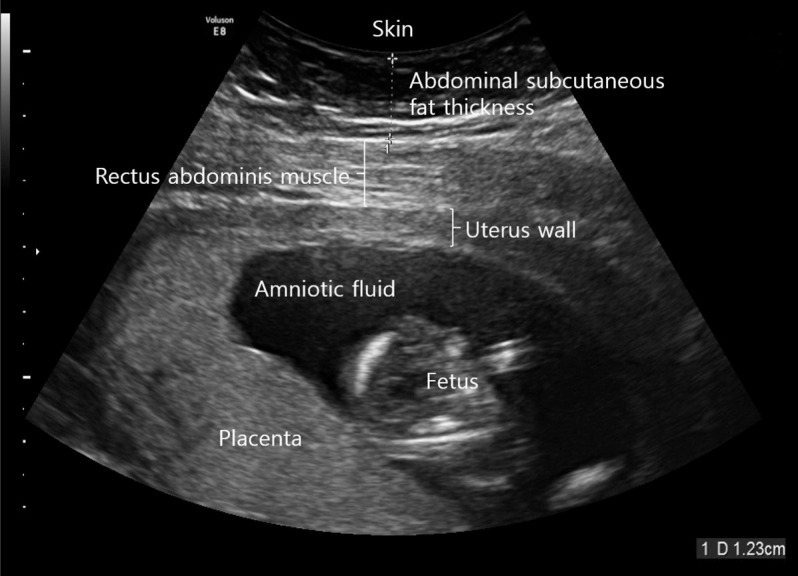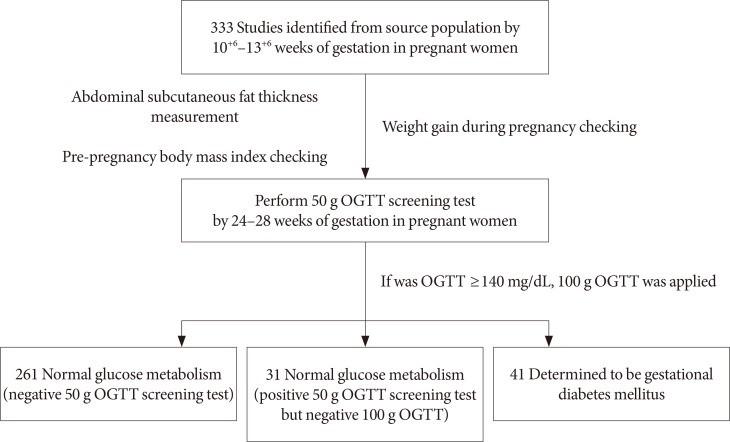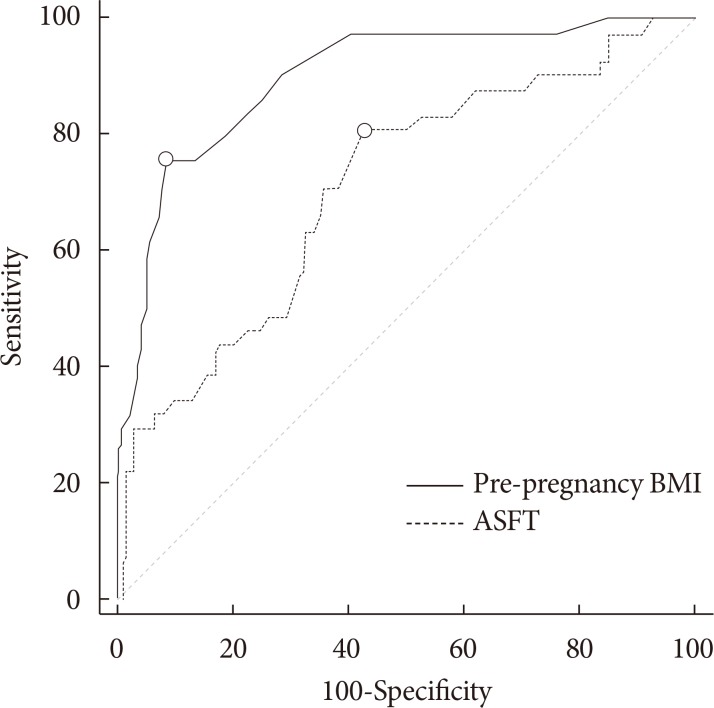Diabetes Metab J.
2017 Dec;41(6):486-491. 10.4093/dmj.2017.41.6.486.
Prediction of Gestational Diabetes Mellitus in Pregnant Korean Women Based on Abdominal Subcutaneous Fat Thickness as Measured by Ultrasonography
- Affiliations
-
- 1Department of Obstetrics and Gynecology, Ilsin Christian Hospital, Busan, Korea.
- 2Department of Radiological Science, College of Health Sciences, Catholic University of Pusan, Busan, Korea.
- 3Department of Radiology, Inje University Busan Paik Hospital, Inje University College of Medicine, Busan, Korea.
- 4Department of Radiology, Inje University Haeundae Paik Hospital, Inje University College of Medicine, Busan, Korea. 033941@paik.ac.kr
- KMID: 2398089
- DOI: http://doi.org/10.4093/dmj.2017.41.6.486
Abstract
- BACKGROUND
This study was performed to verify the correlation between abdominal subcutaneous fat thickness (ASFT) measured by ultrasonography (US) during the first trimester of pregnancy and gestational diabetes mellitus (GDM) of the second trimester in Korean women and to establish a standard of ASFT for predicting GDM.
METHODS
A total of 333 singleton pregnant women participated in this study. Their ASFT was measured by US during the 10+6 to 13+6 weeks of pregnancy; then a GDM confirmatory test (100 g oral glucose tolerance test) was conducted during the 24 to 28 week period of pregnancy. Based on the GDM tests, comparative analyses of the ages of the subjects, pre-pregnancy body mass index (BMI), and weight gain during pregnancy were conducted.
RESULTS
The ages of the subjects and weight gains during pregnancy were not correlated to the GDM of the second trimester of pregnancy, but the pre-pregnancy BMIs (22±3.3 kg/m²) and the ASFT (1.9±0.5 cm) measurements between the control group and subjects during the first trimester of pregnancy were found to show significant differences (P < 0.001). The cut-off value of the ASFT for predicting GDM was determined to be 2.4 cm (area under the curve=0.90, sensitivity 75.61%, specificity 91.78%, P < 0.001). The odds ratio was 2.91 (95% confidence interval, 1.07 to 7.92; P=0.034), which was higher than the 2.4 cm ASFT.
CONCLUSION
It was determined that ASFT as measured by US during the first trimester of pregnancy can be used to predict the risk of developing GDM during the second trimester of pregnancy and for prognosis.
MeSH Terms
Figure
Cited by 3 articles
-
New Diagnostic Criteria for Gestational Diabetes Mellitus and Pregnancy Outcomes in Korea
Kyu Yeon Hur
Diabetes Metab J. 2019;43(6):763-765. doi: 10.4093/dmj.2019.0247.Vitamin D Deficiency at Mid-Pregnancy Is Associated with a Higher Risk of Postpartum Glucose Intolerance in Women with Gestational Diabetes Mellitus
Kyung-Soo Kim, Seok Won Park, Yong-Wook Cho, Soo-Kyung Kim
Endocrinol Metab. 2020;35(1):97-105. doi: 10.3803/EnM.2020.35.1.97.Abdominal skin subcutaneous fat thickness over the gestational period in Korean pregnant women: a descriptive observational study
Moon Sook Hwang
Korean J Women Health Nurs. 2021;27(4):318-325. doi: 10.4069/kjwhn.2021.12.12.
Reference
-
1. Metzger BE, Coustan DR. Summary and recommendations of the Fourth International Workshop-Conference on Gestational Diabetes Mellitus. The Organizing Committee. Diabetes Care. 1998; 21(Suppl 2):B161–B167. PMID: 9704245.2. Kang HJ, Kwak HM, Kim YS, Park JS, Yoon G, Choi SJ, Oh SY, Kim JH, Roh CR. Obstetric and neonatal outcomes after treatment of gestational diabetes mellitus class A1 and class A2. Korean J Obstet Gynecol. 2010; 53:681–686.
Article3. National Diabetes Data Group. Classification and diagnosis of diabetes mellitus and other categories of glucose intolerance. Diabetes. 1979; 28:1039–1057. PMID: 510803.4. Crowther CA, Hiller JE, Moss JR, McPhee AJ, Jeffries WS, Robinson JS. Australian Carbohydrate Intolerance Study in Pregnant Women (ACHOIS) Trial Group. ACHOIS) Trial Group. Effect of treatment of gestational diabetes mellitus on pregnancy outcomes. N Engl J Med. 2005; 352:2477–2486. PMID: 15951574.5. Kim MJ, Lee SK, Lee JA, Lee PR, Park HS. Risk factors for gestational diabetes mellitus in Korean women. Korean J Obes. 2013; 22:85–93.
Article6. Choi HM. Perinatal outcomes associated with prepregnancy body mass index and weight gain during pregnancy. Korean J Obstet Gynecol. 2010; 53:981–987.
Article7. Bray GA, Jablonski KA, Fujimoto WY, Barrett-Connor E, Haffner S, Hanson RL, Hill JO, Hubbard V, Kriska A, Stamm E, Pi-Sunyer FX. Diabetes Prevention Program Research Group. Relation of central adiposity and body mass index to the development of diabetes in the Diabetes Prevention Program. Am J Clin Nutr. 2008; 87:1212–1218. PMID: 18469241.
Article8. Sadro CT, Dubinsky TJ. CT in pregnancy: risks and benefits. Appl Radiol. 2013; 42:6–16.9. Bartha JL, Marin-Segura P, Gonzalez-Gonzalez NL, Wagner F, Aguilar-Diosdado M, Hervias-Vivancos B. Ultrasound evaluation of visceral fat and metabolic risk factors during early pregnancy. Obesity (Silver Spring). 2007; 15:2233–2239. PMID: 17890491.
Article10. Landy HJ, Gomez-Marin O, O'Sullivan MJ. Diagnosing gestational diabetes mellitus: use of a glucose screen without administering the glucose tolerance test. Obstet Gynecol. 1996; 87:395–400. PMID: 8598962.
Article11. World Health Organization. Regional Office for the Western Pacific. The Asia-Pacific perspective: redefining obesity and its treatment. Sydney: Health Communications Australia;2000.12. Metzger BE. Long-term outcomes in mothers diagnosed with gestational diabetes mellitus and their offspring. Clin Obstet Gynecol. 2007; 50:972–979. PMID: 17982340.
Article13. Park MI, Kim JJ, Lee JH, Kim SR, Ahn YH. The significance of 50 gm-oral glucose tolerance test in the screening of gestational diabetes mellitus. Korean J Obstet Gynecol. 1998; 41:2126–2130.14. Makgoba M, Savvidou MD, Steer PJ. An analysis of the interrelationship between maternal age, body mass index and racial origin in the development of gestational diabetes mellitus. BJOG. 2012; 119:276–282. PMID: 22044452.
Article15. Philipsen A, Carstensen B, Sandbaek A, Almdal TP, Johansen NB, Jorgensen ME, Witte DR. Reproducibility of ultrasonography for assessing abdominal fat distribution in a population at high risk of diabetes. Nutr Diabetes. 2013; 3:e82. PMID: 23917154.
Article16. Kennedy NJ, Peek MJ, Quinton AE, Lanzarone V, Martin A, Benzie R, Nanan R. Maternal abdominal subcutaneous fat thickness as a predictor for adverse pregnancy outcome: a longitudinal cohort study. BJOG. 2016; 123:225–232. PMID: 26840907.
Article
- Full Text Links
- Actions
-
Cited
- CITED
-
- Close
- Share
- Similar articles
-
- Abdominal skin subcutaneous fat thickness over the gestational period in Korean pregnant women: a descriptive observational study
- Fetal Hyperinsulinemia and Ultrasonographic Measurement of Fetal Growth in Pregnancy Complicated by Gestational Diabetes Mellitus
- Prediction and Prevention of Large for Gestational Age in Gestational Diabetes Mellitus
- Thickness of Rectus Abdominis Muscle and Abdominal Subcutaneous Fat Tissue in Adult Women: Correlation with Age, Pregnancy, Laparotomy, and Body Mass Index
- Abdominal Subcutaneous Fat Thickness Measured by Ultrasonography Correlates with Hyperlipidemia and Steatohepatitis in Obese Children




